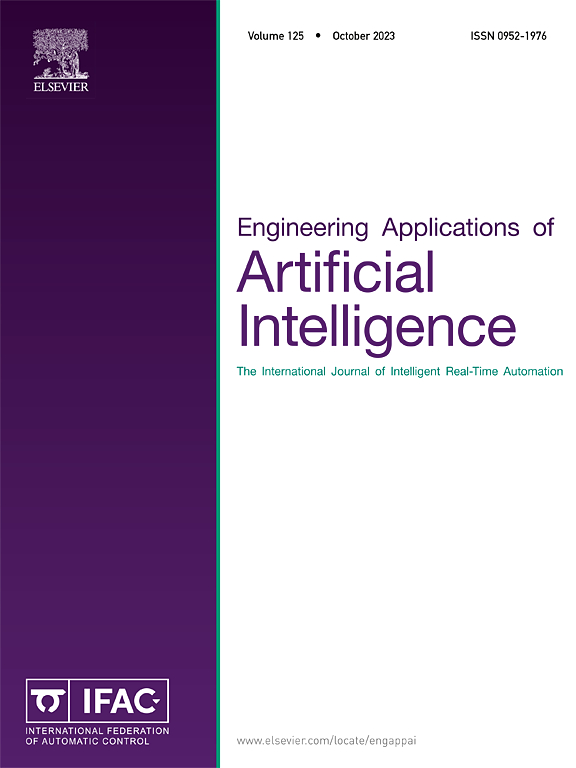Research on efficient and fast extraction of vineyard navigation path based on key point detection
IF 8
2区 计算机科学
Q1 AUTOMATION & CONTROL SYSTEMS
Engineering Applications of Artificial Intelligence
Pub Date : 2025-07-02
DOI:10.1016/j.engappai.2025.111549
引用次数: 0
Abstract
This study proposes an improved model based on key point detection, the YOLOv8-KN (You Only Look Once version 8-Keypoint Detection Navigation) model, which is used for autonomous navigation path extraction of agricultural robots in vineyards. The model comprehensively optimizes the original network structure by introducing FasterNet Block, Efficient Multi-Scale Attention (EMA), Universal Inverted Bottleneck (UIB) module, and Upsampling by Dynamic (DySample) dynamic upsampler. The improved network can accurately locate the key points of grapevine rhizomes directly from the image, and use the least squares method to achieve fast straight-line fitting of the key points on the left and right sides, thereby generating a high-precision navigation path. In the experiment, the model achieved an average precision of 87.1% and a key point detection precision of 91.2% on the grapevine rhizome detection task. At the same time, the model parameters are reduced by 25.8% compared with the original structure, and the computational complexity is controlled within 6.7 Giga Floating-point Operations Per Second (GFLOPs). For navigation path extraction, the evaluation results show that the average yaw angle of the method is only 0.75°, the maximum yaw angle is 1.47°, the average pixel offset error is 7.94 pixels, the maximum offset error is 14.04 pixels, and the average path fitting time is only 1.66 milliseconds (ms). The experimental results thoroughly verify the efficiency and precision of the proposed model in vineyards and provide a lightweight and high-performance solution for the autonomous navigation of agricultural robots in unstructured environments such as vineyards.
基于关键点检测的葡萄园导航路径高效快速提取研究
本研究提出了一种基于关键点检测的改进模型——YOLOv8-KN (You Only Look Once version 8-Keypoint detection Navigation)模型,用于葡萄园农业机器人自主导航路径提取。该模型通过引入FasterNet Block、Efficient Multi-Scale Attention (EMA)、Universal Inverted Bottleneck (UIB)模块和Dynamic (DySample)动态上采样器进行上采样,对原有网络结构进行了全面优化。改进后的网络可以直接从图像中准确定位葡萄根茎的关键点,并利用最小二乘法对左右两侧的关键点进行快速直线拟合,从而生成高精度的导航路径。在实验中,该模型对葡萄藤根茎检测任务的平均精度为87.1%,关键点检测精度为91.2%。同时,模型参数比原结构降低了25.8%,计算复杂度控制在6.7 Giga浮点运算/秒(GFLOPs)以内。对于导航路径提取,评价结果表明,该方法的平均偏航角仅为0.75°,最大偏航角为1.47°,平均像素偏移误差为7.94像素,最大偏移误差为14.04像素,平均路径拟合时间仅为1.66毫秒(ms)。实验结果彻底验证了该模型在葡萄园中的效率和精度,为葡萄园等非结构化环境中农业机器人的自主导航提供了一种轻量化、高性能的解决方案。
本文章由计算机程序翻译,如有差异,请以英文原文为准。
求助全文
约1分钟内获得全文
求助全文
来源期刊

Engineering Applications of Artificial Intelligence
工程技术-工程:电子与电气
CiteScore
9.60
自引率
10.00%
发文量
505
审稿时长
68 days
期刊介绍:
Artificial Intelligence (AI) is pivotal in driving the fourth industrial revolution, witnessing remarkable advancements across various machine learning methodologies. AI techniques have become indispensable tools for practicing engineers, enabling them to tackle previously insurmountable challenges. Engineering Applications of Artificial Intelligence serves as a global platform for the swift dissemination of research elucidating the practical application of AI methods across all engineering disciplines. Submitted papers are expected to present novel aspects of AI utilized in real-world engineering applications, validated using publicly available datasets to ensure the replicability of research outcomes. Join us in exploring the transformative potential of AI in engineering.
 求助内容:
求助内容: 应助结果提醒方式:
应助结果提醒方式:


